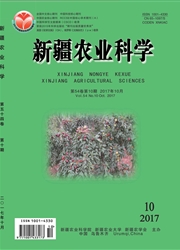

 中文摘要:
中文摘要:
【目的】FeCl3溶液可导致葡萄白藜芦醇积累但机制不明,研究Halliwell-Asada(H-A)途径与白藜芦醇积累的关系在损伤保护角度。【方法】FeCl3溶液处理葡萄叶片后,检测细胞损伤程度和活性氧水平,分析白藜芦醇与H-A途径相关基因表达变化规律。【结果】FeCl3溶液造成叶片活性氧积累与叶片损伤正相关,且伴随白藜芦醇呈量效关系积累,峰值36.83μg/g;白藜芦醇合成途径以及H-A途径下相关酶PAL、C4H、4CL、STS、APX和MDAR的基因表达量除DHAR基因外均明显上调;H2O2协同处理增加白藜芦醇含量,抗氧化剂NAC和GSH-EE协同则相反。【结论】Fe Cl3溶液降低葡萄叶片H-A途径对活性氧的清除能力,造成氧化胁迫并引起白藜芦醇积累,提示白藜芦醇合成与H-A途径存在偶联。
 英文摘要:
英文摘要:
【Objective】FeCl3 solution causes the accumulation of resveratrol,but the mechanism is not clear. Here we aim to study the relationship between the Halliwell-Asada( H-A) pathway and resveratrol accumulation from the perspective of damage protection. 【Method 】After FeCl3 solution treatment of grape leaves,the degree of cell damage and the level of reactive oxygen species were detected,and the expression of resveratrol and H-A pathway related genes were analyzed. 【Result】The results showed that the oxidative stress level of leaves treated with FeCl3 solution were positively correlated with the damage of foliar tissue. A significant resveratrol accumulation was also observed. In addition, the maximum content of resveratrol reached 36. 83 μg/g after treatment in a dose-dependant manner. The gene expression levels of resveratrol metabolic enzymes and key enzymes in H-A pathway were increased in FeCl3 treatment,such as PAL,C4 H,4 CL,STS,APX and MDAR except DHAR. Resveratrol contents in H2O2 co-treatment were raised,contrary to co-treatments of antioxidant reagents NAC and GSH-EE. 【Conclusion】FeCl3 solution decreased ROS scavenging capability of H-A pathway,thus causing oxidative stress and leading to resveratrol accumulation in grapevine samples,which underlines a correlation between resveratrol metabolism and H-A pathway.
 同期刊论文项目
同期刊论文项目
 同项目期刊论文
同项目期刊论文
 期刊信息
期刊信息
